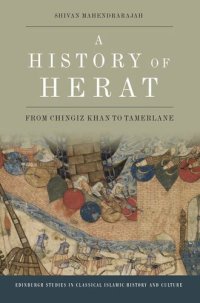
Ebook: A History of Herat: From Chingiz Khan to Tamerlane
Author: Shivan Mahendrarajah
- Year: 2022
- Publisher: Edinburgh University Press
- Language: English
- pdf
Shows how and why an ancient city destroyed and then rebuilt by Mongols became again the ‘Pearl’ of the Iranian east
- Establishes a sequence and chronology for the Mongol attacks in eastern Iran
- Includes a political-military history of the Kart dynasty, from their founding in 649/1251 by Möngke Qaʾan, to their surrender to Tamerlane in 783/1381
- Explores the renewal of agriculture, commercial development (caravansarays and bazaars) and the revivification of Islamic activities (patronage of madrasas, hospices, and mosques)
- Illustrates the reconstruction of Herat’s intricate hydrological network of channels, dams, cisterns, sluices, controllers and watermills with maps and schematics
- Details Herat’s fortified landscape (citadel, curtain walls, embankment, trench, gateways, towers and Kartid Walls) and analyses the city’s defensive postures
This book tells the history of Herat, from its desolation under Chingiz Khan in 1222, to its capitulation to Tamerlane in 1381. Unlike the other three quarters of Khurasan (Balkh, Marw, Nishapur), which were ravaged by the Mongols, Herat became an important political, cultural and economic centre of the eastern Islamic world. The post-Mongol age in which an autochthonous Tajik dynasty, the Kartids, ruled the region set the foundations for Herat’s Timurid-era splendors.
Divided into two parts (a political-military history and a social-economic history), the book explains why the Mongol Empire rebuilt Herat: its rationales and approaches; and Chinggisid internecine conflicts that impacted on Herat’s people. It analyses the roles of Iranians, Turks and Mongols in regional politics; in devising fortifications; in restoring commercial and cultural edifices; and in resuscitating economic and cultural activities in the Herat Quarter.